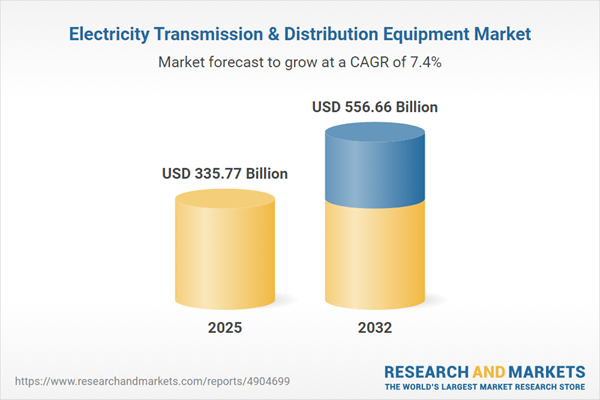Speak directly to the analyst to clarify any post sales queries you may have.
The electricity transmission and distribution equipment market is entering a period of unprecedented transformation, driven by digital innovation, policy shifts, and evolving energy needs. In this context, senior leaders face pivotal choices on investment, grid modernization, and strategic partnerships to ensure reliable and resilient power delivery.
Market Snapshot of the Electricity Transmission & Distribution Equipment Sector
The electricity transmission and distribution equipment market grew from USD 314.15 billion in 2024 to USD 335.77 billion in 2025 and is projected to continue expanding at a CAGR of 7.41%, reaching USD 556.66 billion by 2032. This robust growth reflects ongoing modernization, surging energy demand, and increased integration of renewable power sources in grid infrastructure around the world.Scope & Segmentation of the Electricity Transmission and Distribution Equipment Market
This report delivers a comprehensive view, spanning the full spectrum of equipment, voltage levels, applications, regional footprints, and leading market participants shaping industry direction.
- Equipment Types: Highlights include cables and wires (overhead, submarine, underground), capacitors, inductors, meters, switchgear (HV, MV, LV), and transformers (distribution, isolation, power).
- Voltage Levels: High voltage, medium voltage, and low voltage infrastructure, each with unique operational and regulatory requirements.
- Applications: Commercial such as healthcare, office, and retail; industrial including manufacturing, mining, and utilities; residential networks with a focus on smart integrations.
- Geographical Regions: Americas (North America, Latin America), Europe, Middle East & Africa (including UK, Germany, France, MEA countries), and Asia-Pacific (China, India, Japan, and others).
- Key Companies: Includes ABB Ltd., GE Vernova, Siemens Energy AG, Schneider Electric SE, Hitachi Energy, Mitsubishi Electric Corporation, Prysmian Group, and other notable industry participants.
Key Takeaways for Senior Decision-Makers
- Digital grid technologies and real-time asset monitoring are redefining lifecycle management, enabling transition from reactive to predictive maintenance approaches.
- Investment in energy storage and distributed energy resources is driving fundamentally new network architectures, with utilities adapting to increased system flexibility and evolving demand patterns.
- Product innovations—spanning composite materials, modular designs, and advanced diagnostics—enable cost optimization and speedier grid upgrades while supporting sustainability targets.
- Regional market differences require tailored approaches to technology adoption, regulatory alignment, and financing, reflecting diverse stages of grid modernization.
- Strategic alliances and M&A activity are yielding access to specialized technical expertise and expanding service-based business models for enhanced customer value.
Tariff Impact on Market Direction
New U.S. tariff policies slated for 2025 are prompting comprehensive reassessments of procurement strategies, production costs, and supply chain configurations. Many manufacturers are seeking alternative sourcing geographies, shifting inventory strategies, and pursuing vertical integration to reduce exposure to fluctuating raw material costs. In parallel, innovation in lightweight and modular components helps mitigate financial risk and safeguard competitiveness in a changing regulatory climate.
Methodology & Data Sources
The research draws on a mixed-methodology approach blending primary interviews with industry experts, utility leaders, engineers, and policy advisors, alongside deep secondary reviews of technical publications, conference proceedings, and regulatory filings. Peer reviews and data triangulation ensure robust, actionable insights.
Why This Report Matters for Strategic Planning
- Provides actionable intelligence on technology, policy, and investment trends essential for resilient infrastructure planning.
- Illuminates segment-specific opportunities, from smart distribution and microgrid projects to grid cybersecurity and resource optimization.
- Enables informed decision-making to adapt supply chains, product development, and service offerings to evolving market imperatives.
Conclusion
Forward-thinking organizations that leverage the comprehensive analysis and strategic insights in this report will be best placed to navigate disruption, capture growth opportunities, and deliver reliable, future-ready energy solutions.
Additional Product Information:
- Purchase of this report includes 1 year online access with quarterly updates.
- This report can be updated on request. Please contact our Customer Experience team using the Ask a Question widget on our website.
Table of Contents
3. Executive Summary
4. Market Overview
7. Cumulative Impact of Artificial Intelligence 2025
Companies Mentioned
The companies profiled in this Electricity Transmission & Distribution Equipment market report include:- ABB Ltd.
- Bharat Heavy Electricals Limited
- CG Power and Industrial Solutions Limited
- DAIHEN Corporation
- Dinkle International Co. Ltd.
- Eaton Corporation PLC
- Fuji Electric Co., Ltd.
- GE Vernova
- Hammond Power Solutions, Inc.
- HD Hyundai Electric Co., Ltd.
- Hitachi Energy Ltd.
- Hubbell Incorporated
- KEI Industries Limited
- Kirloskar Electric Company Ltd.
- Larsen & Toubro Limited
- Legrand S.A.
- Mersen Corporate Services SAS
- Mitsubishi Electric Corporation
- Nexans S.A.
- Prysmian Group
- S&C Electric Company
- Schneider Electric SE
- Schweitzer Engineering Laboratories, Inc.
- SGB-SMIT Group
- Siemens Energy AG
- Sumitomo Electric Industries, Ltd.
- TBEA Co., Ltd.
- Toshiba Corporation
- ZTT Group
Table Information
| Report Attribute | Details |
|---|---|
| No. of Pages | 180 |
| Published | November 2025 |
| Forecast Period | 2025 - 2032 |
| Estimated Market Value ( USD | $ 335.77 Billion |
| Forecasted Market Value ( USD | $ 556.66 Billion |
| Compound Annual Growth Rate | 7.4% |
| Regions Covered | Global |
| No. of Companies Mentioned | 29 |









